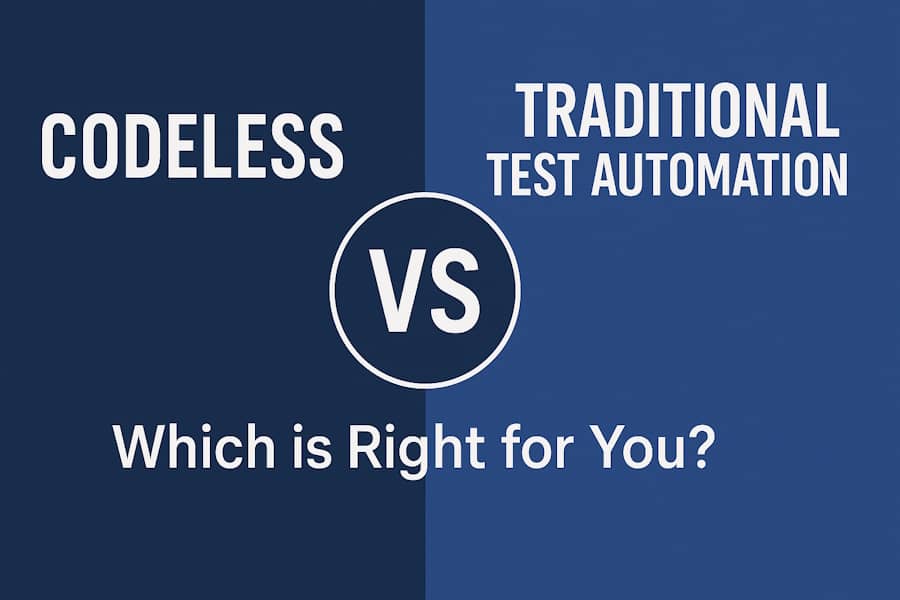Software testing has undergone significant changes over the last few years. The main reason for that is the growth in the complexity of the software itself. Earlier software used to be much simpler. They were designed for a specific objective. A financial software would contain all the calculation logic necessary to produce the desired outcome. Utility was prioritized over usability. But as the software evolved, it increasingly became more comprehensive and user-friendly. With additional elements built into them, the need for extensive testing arose as well.
Manual testing started to prove insufficient both in quality and feasibility to cover all aspects of sophisticated software. It became impractical to run numerous test cases while keeping deliverability and deadlines in mind. Hence, test automation emerged as an obvious solution. It made the testing more efficient and faster, yet it was not a final solution. It needed testers to write code in a programming language, which was an extra overhead in itself. That problem was solved by the introduction of codeless testing. But no matter how testing approaches evolve, every previous stage carries its own strengths as well, which make it irreplaceable. This article will specifically explore the two latest stages in the evolution of software testing: codeless testing and test automation. We will examine the strengths and weaknesses of both approaches and conclude which approach is more useful.
What is Codeless Testing?
Codeless testing is a type of testing that can perform all the tasks in testing, test case creation, execution, and defect logging, automatically. These tools are mostly developed through AI technology, which makes them more intelligent to perform test-related tasks. All they need is for the administrator to perform the initial configuration and integration with the application to be tested. Then, testers can pass the instructions to the tool in the way they want to test.
Features of Codeless Testing Tools
A few features of a codeless testing tool are:
Test Automation
What this means is that the test cases are not only generated automatically but also executed and logged. All you need to do is to integrate the AI testing tool with the application while creating the test suite. Once done, the test creation, execution, and defect logging can all be done by just mouse clicks. A test case, once created, can be run any number of times with a simple click.
Auto-generation of Test Cases
This feature is what places Codeless testing tools above traditional automated testing tools. Codeless test automation can generate test cases automatically through human prompts in natural language. Using its GenAI models, it understands the instructions in simple language and a brief description of the application and generates test cases accordingly. The test cases can be developed to either test individual features or all at once at the application level.
Self-healing
One of the biggest challenges in software testing is the maintenance of test suites. Software products often go through frequent updates in the features, logic, or backend code. While new test cases are needed to validate those changes, old test cases are also required to perform regression testing. Updating the old test cases with the frequent software upgrades is a pain. But AI-powered testing tools have the feature of self-repairing their test cases. They adapt to the frequent changes in the software and continue to run the same test cases without any maintenance overhead.
Predictive Analytics
Manual testing can only test a software in its existing state. The features are tested to determine if they can fulfill business objectives or not. But AI testing takes it one step further. It can not only test the existing software but also predict the bugs that are most likely to occur in the future. It does so by analyzing historical patterns of the defects and their relevant fixes. Based on that knowledge, it identifies the high-risk areas and notifies the user of them. Testers can use this insight to perform testing with extra care for those high-risk areas of the product. This makes the product not only bug-free in the present state but also future-proof.
What is Traditional Automation Testing?
Traditional automation testing lies between manual testing and codeless testing. It is better than manual testing in a way that once the test cases are created, they can be run automatically any number of times.
Weaknesses of Traditional Automation Testing
Their main drawback, when compared to codeless testing, is that they require test cases to be created using a programming language. This creates a technical barrier in the team. Testers should not only possess functional and business knowledge but also technical knowledge to be able to create test cases. Companies need to spend an extra amount to hire testers with a technical background. Additionally, the testing can be done only by test specialists, but not by anyone else. Sometimes, non-technical testers, like product owners or business analysts, also want to test the product but can’t do so through traditional automated testing. This narrows down the test coverage of the product as it depends only on the testers’ choices and excludes the business and non-functional viewpoints.
Strengths of Traditional Automation Testing
While this testing depends on generating test cases through code, it has its own benefits as well. Since test cases can be coded manually, they can possess a thorough and detailed logic than auto-generated test cases. That counts when you want to drill down into something more specific than an AI testing tool can discern. The subtle elements and nuances of the software that need to be tested can be directly coded into the test script and tested. For someone from a technical background, it is much easier to write the code for a specific scenario than to keep jiggling with an AI tool until the desired result is produced.
Conclusion: Which is Better?
At first glance, a codeless testing tool offers larger benefits than a traditional automation tool. But when put into practice, you may encounter scenarios where you would miss the flexibility of generating test cases manually. For complex scenarios that are hard to discern by an AI tool, the traditional method proves to be more useful. And in the cases where time and precision matter more than expansive coverage, codeless tools are more efficient.
So, the best solution is the blend of both. You harness the automatic generation of test cases for simpler scenarios that save time and effort, while using traditional methods for writing complex test scripts. This will allow you to blend efficiency with a detailed testing approach. And the best thing is that most of the modern testing tools allow this. They have an auto-generated test cases feature, but also allow you to write the test cases on your own.
So, the final answer is not “either/or” but a blend of both.








